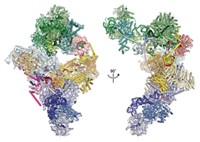Advertisement
Grab your lab coat. Let's get started
Welcome!
Welcome!
Create an account below to get 6 C&EN articles per month, receive newsletters and more - all free.
It seems this is your first time logging in online. Please enter the following information to continue.
As an ACS member you automatically get access to this site. All we need is few more details to create your reading experience.
Not you? Sign in with a different account.
Not you? Sign in with a different account.
ERROR 1
ERROR 1
ERROR 2
ERROR 2
ERROR 2
ERROR 2
ERROR 2
Password and Confirm password must match.
If you have an ACS member number, please enter it here so we can link this account to your membership. (optional)
ERROR 2
ACS values your privacy. By submitting your information, you are gaining access to C&EN and subscribing to our weekly newsletter. We use the information you provide to make your reading experience better, and we will never sell your data to third party members.
Biological Chemistry
Yeast Ribosome Structure Solved
Crystallography: Details of translation machinery could help elucidate mechanism, regulation
by Jyllian N. Kemsley
November 29, 2010
| A version of this story appeared in
Volume 88, Issue 48

Having solved the first crystal structure of a eukaryotic ribosome, scientists are now getting a new, more detailed look at the machinery that translates the genetic code into proteins in all living cells (Science, DOI: 10.1126/science.1194294).
“This is a paper of outstanding significance,” says Columbia University’s Joachim Frank, who has studied eukaryotic ribosomes with cryo-electron microscopy. Such microscopy investigations, however, have produced molecular maps with resolutions greater than 6 Å. With a resolution of 4.15 Å, the new crystal structure pinpoints the various ribosome components and will enable researchers to start studying their interactions in more depth. The details it provides should also allow scientists to glean additional information from cryo-electron microscopy data on ribosomes in different functional states, Frank says.
Ribosomes generally consist of ribosomal RNA (rRNA) and multiple proteins. They are divided into two subunits. The smaller subunit binds to messenger RNA that has been transcribed from DNA. The larger subunit binds to transfer RNAs, which bring amino acids into the complex to assemble into a polypeptide chain.
Several structures of prokaryotic ribosomes have been published. Eukaryotic ribosomes, however, are approximately 40% larger than bacterial ribosomes and contain additional RNA segments and 25 more proteins. The complexity of eukaryotic ribosomes makes them tricky to purify and crystallize as intact complexes in crystals that diffract well, says Marat Yusupov, a research scientist at the Institute of Genetics & Molecular & Cellular Biology, in Illkirch, France. Yusupov, along with postdoctoral researcher Adam Ben-Shem and scientists Lasse B. Jenner and Gulnara Yusupova, prepared the yeast ribosome crystals by starving yeast to inhibit translation and then purifying and crystallizing the stalled ribosomes.
Although the crystals lack mRNA and tRNA, the ribosomes crystallized in what is known as a “ratcheted” form, in which the smaller subunit rotates to advance the mRNA and tRNA and enable processing of the next codon in the mRNA’s base sequence.
The yeast ribosome structure illustrates what researchers had assumed—that the core structure of the ribosome is conserved across evolutionary kingdoms, with additional elements lying mostly at the periphery, says Ada E. Yonath, a professor of structural biology at the Weizmann Institute of Science, in Israel, and a corecipient of the 2009 Nobel Prize in Chemistry for solving prokaryotic ribosome structures.
The fact that the yeast structure is in the ratcheted state will further understanding of “the repertoire of movements and rearrangements that the ribosome undergoes during translation,” Yonath adds.
The structure also reveals a direct link between the entry and exit points for mRNA, something that has not been observed in prokaryotic structures, Yusupov says. The role of various interactions between mRNA, rRNA, and additional protein elements in initiation and termination of translation is something that still needs to be studied, Yusupov adds.
The additional rRNA and proteins in eukaryotic ribosomes, he continues, likely play a role in the regulation of translation. A better understanding of the mechanisms involved could help develop drugs to treat eukaryotic pathogens such as parasites and other human diseases, he says.





Join the conversation
Contact the reporter
Submit a Letter to the Editor for publication
Engage with us on Twitter